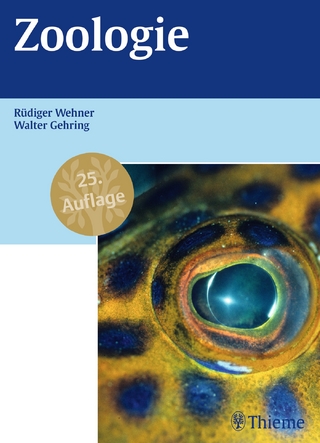
Development Neuropsychobiology
Academic Press Inc (Verlag)
978-0-12-300270-9 (ISBN)
- Titel ist leider vergriffen;
keine Neuauflage - Artikel merken
Contributors
Preface
1. Embryonic Mechanisms
I. Pattern Formation
II. The Limb as a Model System
III. Peripheral Innervation
References
2. Regulation of Nerve Fiber Elongation during Embryogenesis
I. Introduction
II. Neurite Formation In Vitro
III. Regulation of the Route of Neurite Growth In Vitro
IV. Regulation of the Route of Nerve Fiber Elongation In Vivo
V. Is Regulation of Nerve Fiber Growth Related to Synaptogenesis
VI. Summary
References
3. Pathways and Changing Connections in the Developing Insect Nervous System
I. Introduction
II. Embryogenesis: Foundations for Neurogenesis
III. Postembryonic Development: Remodeling en Route
IV. Ectopic Sensilla: An Experimental Approach to Path-finding in the Nervous System
V. Conclusions
References
4. The Normal and Abnormal Development of the Mammalian Visual System
I. Introduction
II. Patterns of Organization
III. Normal Development
IV. Variants of Normal Development
V. Discussion
VI. Conclusions
References
5. Do Neurotransmitters, Neurohumors, and Hormones Specify Critical Periods
I. An Hierarchical Model for the Specification of Critical Periods
II. Neurotransmitters and Neurohumors as Develomental Signals
III. Hormones as Temporal Regulators of Postnatal Neurogenesis
IV. Hormonal-Humoral Interactions
V. Drugs, Stress, and Other Environmental Influences on the Humoral and Hormonal Milieu of the Developing Nervous System: Implications for Their Teratogenic Effects
VI. Summary and Conclusions
References
6. Sexual Differentiation of the Brain
I. Introduction
II. Possible Mechanisms of Steroid Action
III. Sexual Dimorphism of Brain Structure
IV. The Possible Role of a-Fetoprotein
V. The Possible Importance of Estrogen Per Se
VI. An Experimental Approach to the Problem
VII. How Might Hormones Change Growth Patterns and Neuronal Circuits
VIII. Hormonal Effects: Direct or Indirect
IX. In Vitro Veritas
References
7. Behavioral Neuroembryology: Motor Perspectives
I. Introduction
II. History
III. Embryology of Behavior and Its Neural Correlates
IV. Development of Specific Motor Patterns
V. Tissue Culture Approaches to Neurobehavioral Problems
VI.Conclusions and Future Priorities
References
8. Ontogeny of the Encephalization Process
I. Behavioral Development
II. Encephalization of the Spinal Motor System
III. The Encephalization Process
IV. Interference with Encephalization
References
9. Neuronal Activity as a Shaping Factor in Postnatal Development of Visual Cortex
I. Introduction
II. Experience Effects on Binocularity
III. Evidence for a Central Control of Experience-Dependent Modifications
IV. A Voltage-Dependent Threshold for Hebbian Modifications
V. The Chemical Nature of Permissive Gating Signals
VI. Implications for Normal Development
VII. Concluding Remarks
References
10 Experience and Development in the Visual System: Anatomical Studies
I. Introduction
II. Normal Development
III. Effects of Visual Deprivation on Development
IV. Binocularly Competitive and Noncompetitive Mechanisms
V. Summary and Conclusions
References
11. Experience and Visual Development: Behavioral Evidence
I. Introduction: General Perspectives and Methodology
II. Specific Visual Capacities and Sensory Experience
III. Concluding Observations
References
12. Neural Correlates of Development and Plasticity in the Auditory, Somatosensory, and Olfactory Systems
I. Introduction
II. The Auditory System
III. The Somatosensory System
IV. The Olfactory System
V. Dimensions of Plasticity
VI. Implications for Behavior
References
13. What's Special about Development? Thoughts on the Bases of Experience-Sensitive Synaptic Plasticity
I. Introduction
II. Overproduction of Synapses and Expected Information
III. Synaptogenesis and Unexpected Information
IV. Mechanisms of Synapse Pattern Change in Later Development and Adulthood
V. Conclusions
References
14. Sex Differences in Developmental Plasticity of Behavior and the Brain
I. Introduction: Human Development
II. Sex Differences in Animals in Response to the Environment
III. Implications for Human Sex Differences
References
15. The Development of Olfactory Control over Behavior
I. Introduction
II. Orientation
III. Contact Behavior (Huddling)
IV. Suckling
V. Olfactory Conditioning outside the Nest
VI. Neural Development of the Olfactory System
VII. A Model for Olfactory Modification of Behavior during Ontogeny
VIII. Conclusions and Future Directions
References
16. New Views of Parent-Offspring Relationships
I. Introduction
II. Some Seminal Concepts: Antecedents to New Views
III. Concepts of Infancy and Development
IV. Models of Parent-Offspring Relationships
V. Form and Functions of Parent-Offspring Relationships
References
Index
| Erscheint lt. Verlag | 21.5.1986 |
|---|---|
| Verlagsort | San Diego |
| Sprache | englisch |
| Gewicht | 990 g |
| Themenwelt | Naturwissenschaften ► Biologie ► Zoologie |
| ISBN-10 | 0-12-300270-2 / 0123002702 |
| ISBN-13 | 978-0-12-300270-9 / 9780123002709 |
| Zustand | Neuware |
| Haben Sie eine Frage zum Produkt? |
aus dem Bereich


